Broadway: Ready for Business
Legendary Road Awaits New Vision
First mapped in 1835, first paved in 1891, Broadway was where Long Branch conducted commerce. The Slocum family is credited with developing this old Indian route — part of the Minisink Trail — into a passable wagon road.
Historically, I’ve seen the road called: Fish Path, Eatontown & Long Branch Turnpike, Broadway Turnpike, Chelsea Road, Depot Avenue and Main Street. In 1734 the first entity in Long Branch, an Indian fishery, was established on lower Broadway. Michael Maps and Richard Wyckoff opened the first general store on Broadway in 1812. The Long Branch Commission acquired the road charter for Broadway in February 1874 paying about $7,000.
During Broadway’s glory business times, Jacob Steinbach and his grand department store ruled the street. There were several hotels, banks and drugstores, a dozen clothing stores, two theaters brought historic innovation and star power, there were numerous places to eat and grocery shop, you could buy a car on Broadway (the street had 10 auto dealers in 1957), and City Hall and the City Library were just up the road.
Once a bustling and vibrant avenue, it served as the city’s main hub of commerce and connectivity for over a century, Broadway played a crucial role in shaping the identity and economic growth of the city. It was so Long Branch.
“Commerce changes the fate and genius of nations.”
—Thomas Gray
In sad decline for too long, today most of lower Broadway building-wise has been removed from existence. Leveled flat in 2018. The foot of Broadway is basically an empty canvas. Just waiting for someone with vision and deep pockets to take hold and recreate. This once majestic but now neglected part of the city needs that plan and that person. Now, more than ever. The images of Broadway presented here — pages from city history — must serve to inspire people and plans. Underdeveloped and neglected for far too long, the “New Broadway” project is something to be encouraged about.
Jared Kushner (former President Trump’s son-in-law) acquired the Broadway corridor property for $22 million, according to public remarks at a 2022 city council meeting. That could work well. The savvy, billionaire real-estate investor already owns the city’s Pier Village (since 2014) and is the process of remaking Monmouth Mall in Eatontown too (which he acquired in 2021). Indeed, construction has begun at a 11-acre Lower Broadway site — set to be a $130 million mixed-use residential and retail development.
In good times, Broadway represented the city at its pinnacle. A point of major coastal commerce with all sorts of businesses. Land where Long Branch “Entertained a Nation.” That’s a lot to live up to. “Redeveloping” this neighborhood was never going to be an easy job. A neat residential-commercial mix is probably what’s needed — Long Branch has a rich history of mixing. And Broadway still has grit — only its lost stature awaits return. May the glory return.
The following photo essay recalls and hopes for a new birth for Broadway:

City Circle — Lower Broadway under re-development by Kushner Companies, June 2024 (Jersey Shore Drone Services Photo). Lower Broadway (North and South) had its up and downs over the past 150 years — with hotels and auto dealers, restaurants and bars, food markets and pharmacies filling the bustling block. Also in the neighborhood were two major theaters and a firehouse. Early trains had stops there too. All steps away from the city’s crown jewel — the Atlantic Ocean. Today it’s largely a blank slate.
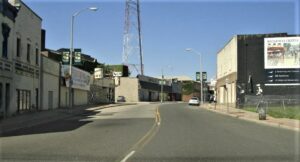
All Gone Now — Lower Broadway looking west, 2011. Heading uptown — the city’s old radio station tower in the distance. WRLB-FM 107.1 was launched in October 1960.
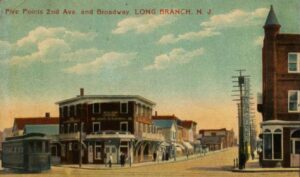
“5 Corners” Intersection — Second Avenue and Lower Broadway, 1901. The Columbia Hotel (r) was built in 1896 by Joseph H. Flanigan, a committeeman when Long Branch was part of Ocean Twp (he died in 1911). Later on it became the Landmark Hotel and was torn down in 1995.

What’s Next? — Lower Broadway at dawn, December 2019 (David Booth Photo). It’s not the first time the area has been in want of a redo. Its beginnings, like much of seashore Long Branch, involved boarders and booze. The area’s first hotel, the Keystone, opened in the middle of the Civil War in 1863, and several more followed. By 1870, commerce had taken root when 16 new stores on the block were opened. After an 1874 fire burned most of Lower Broadway “to the ground,” the area began to decline. With the opening of the new ocean pier in 1879 nearby, the “number of drinking places increased.” These poorly constructed but licensed establishments were “nearly continuous from the railroad tracks to the sea.” Going back 120 years now, city officials considered the location an “obnoxious neighborhood,” an “eyesore,” and a “long abode of vice.” Called “The Bowery” it was where “immorality runs rampant.” According to the Long Branch Daily Record, the city’s “main thoroughfare, which should be the most attractive in the community, has been for years a menace to society.” In May 1905, the city got a common pleas court ruling to effect changes to this “immoral blot” on the new city.
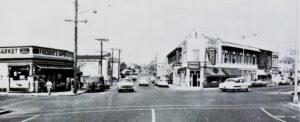
Downtown — Lower Broadway, 1958. According to a May 1905 Long Branch Daily Record story on the development of lower Broadway, the area was also called the “Triangle” (CJ Rubin Photo).
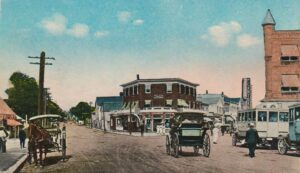
Cars & Horses — Lower Broadway and Second Avenue, 1912. In the center is the Arcade Hotel — built in 1867 and wrecked in 1927; John H. Campbell was a longtime proprietor.
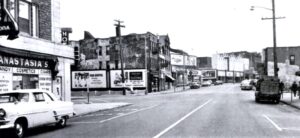
City Rx — 5 Corners Broadway, 1934. At left is Anastasia’s Pharmacy, opened in 1926; damaged by fire in July 1969. Relocated to 120 Broadway, the drug store closed in 1976. Owner, Amerigo A. “Doc” Anastasia, was a longtime city pharmacist and school board president. A graduate of the Columbia University College of Pharmacy, the much-admired city native (he had two city schools named for him) died in May 1982.

Beer & Pizza — Lower South Broadway, 1948. From left: Freddie’s Tavern & Package Goods and Rex Restaurant-Pizzeria — a couple of Lower Broadway anchor businesses. Fred Tarantolo sold Rex in 1976 after nearly 40 years of Broadway business (he died in 1980). From 1937 Alfred Monaco and family ran Freddie’s for some 40 years (he died in 1965) until the mid-1970s.
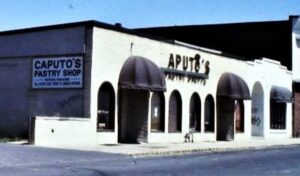
Sole Survivor — The original Caputo’s Italian Pastry Shoppe at 31 South Broadway, 1970s. Joseph Caputo, Sr. started the business in June 1960. Born in Italy, he started baking in Brooklyn in 1923 (“where everything is made from scratch”) and summered in Oceanport; he died in February 1974. After the property was “blighted” by the city council in March 1984, his son Jack moved operations to the family-developed Ursula Plaza in 1988 (the city and the family had swapped locations in 1987). Grandson Joseph is the fifth generation family member to run the bakery which still operates successfully today — MORE INFO.
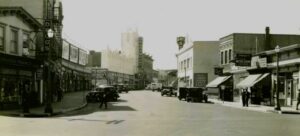
Lower Broadway looking uptown, 1940s (NJ State Archives Photo).
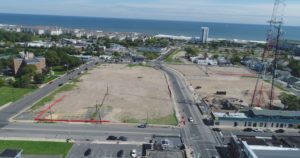
Blank Slate — Lower Broadway aerial image looking east, 2018. More than 50 dilapidated old buildings were removed during 2017. In early 2015, a new CVS Pharmacy opened at Broadway and Ocean Blvd. The 13,000-square-foot chain drugstore represented the first major construction investment in Lower Broadway in over 25 years. Note: “Doc” Anastasia operated his Lower Broadway pharmacy for over 40 years.

City’s Condemnation — Map of Lower Broadway, Red Bank Daily Register, December 1983. Two months later the Long Branch City Council “blighted” much of the neighborhood — condemning the properties of residents and merchants in a 7-acre area. Several area property owners fought the city’s action but lost on appeal in July 1986.
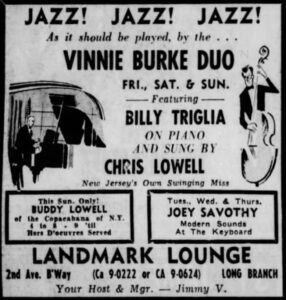
Fun Too — Landmark Lounge ad, 1963. It was part of the old Landmark Hotel. I heard a rumor that Frank Sinatra performed here one evening in the early 1940s and was so bad he was booed off the stage.
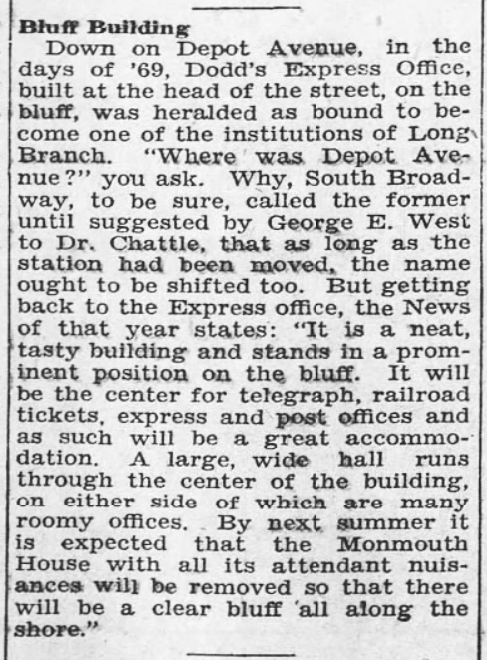
Remember “Depot Aevnue?” Long Branch Daily Record, April 1933. Lower Broadway had two train stations in its day staring in 1870; Samuel Cooper donated the land.
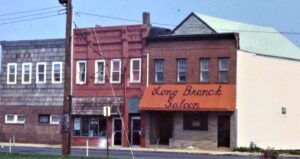
Long Branch Saloon on Lower Broadway, 1980s. In the late 1970s, the place was a go-go bar known as the “Bottom-of-the-Barrel.” (Dan Hennessey Photo). It was cited several times by the city council and the state ABC for “lewd behavior” by dancers. Chester LaDue, Mervin Mohler, and Raymond Sherrier had acquired ithe bar n June 1979.
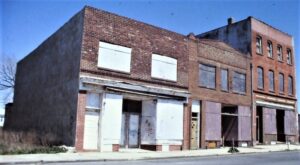
Lower Broadway in decline, late 1970s. The city planning board also voted to condemn the neighborhood in 1983.
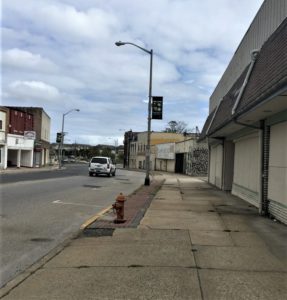
Lower Broadway buildings before demolition, 2015. Back when a judge in Freehold approved all liquor licenses, more than 140 were granted in the Long Branch area for the year 1910.
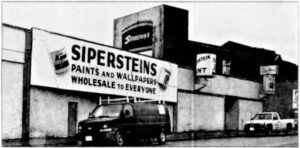
Ask Larry — Siperstein’s Paint & Wallpaper store on Broadway. The family-owned business was started here in July 1962 by Larry Katz, a former Linden high school teacher. Nathan Siperstein had opened the first of a 21-store chain in Jersey City in 1904. In 2005, the city business moved into the old Brunswick Monmouth Lanes bowling alley on Joline Avenue and operates today as Sip’s Ace Paint & Hardware. Larry, who held a Master’s Degree in marketing from NYU and was known for his 60-hour work weeks, died in March 2014. Prior to Siperstein’s, Edward Odiotti had owned the West End Paint Co. there since 1950.
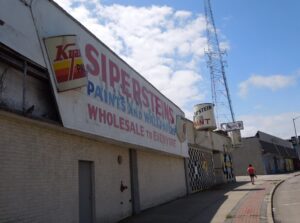
Paint the Town — Old Siperstein’s Paint & Wallpaper store on Lower Broadway, 2012. Operating today as Sip’s Ace Paint & Hardware.
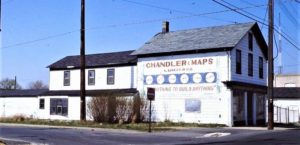
Chandler & Maps Company on Lower Broadway, 1970s (Dan Hennessey Collection). Augustus Chandler and Thomas Maps started the landmark building business here in 1890; both men died in 1922. Native born in 1849, Chandler was also a Long Branch mayor (from 1899-1900) and commissioner.

Chandler & Maps Lumber Company promo aerial photo, 1953. Gross sales for lumber business topped $700,000 in 1950 — best in the city. C&M shut its doors forever in January 1991.
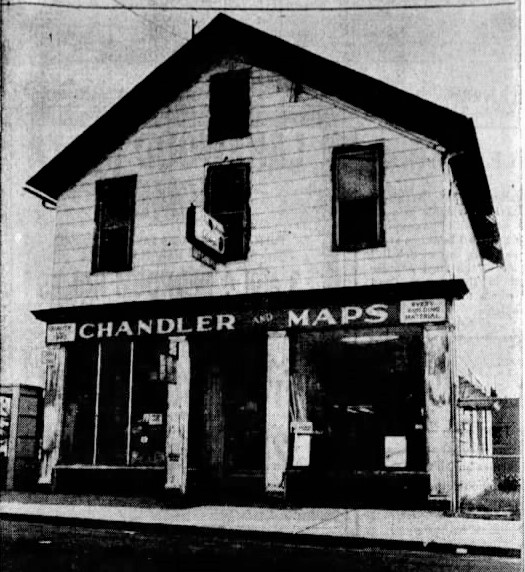
Chandler & Maps front, 1973. Sidney Binder, a Long Branch CPA, bought the business in 1959. Richard Eisele was the longtime general manager there as was Frank Schantz.
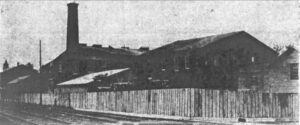
Chandler & Maps Lumber Yard at 70 South Broadway, 1908. Its timber was used to build the Shadow Lawn building at Monmouth U in WLB and new Monmouth Park in Oceanport.
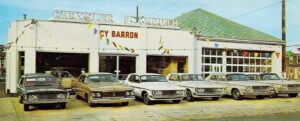
Buying a Car — Cy Barron Chrysler-Plymouth-Imperial auto dealership on Lower Broadway, 1963. Seymour “Cy” Barron was a pioneering auto dealer in Long Branch beginning in the late 1940s. The city native was a LBHS graduate and captain of its basketball team. He died in June 2012. There was an age when selling cars in Long Branch was a big business. In 1927 the Long Branch Auto Dealers Association was formed with 15 independent members. By 1957 no less than 10 dealers were selling cars on Broadway. Including: Barron & Jarmon, Finn Buick, McFaddin Motors, Kitson Chevrolet, Jones Motors, Heimlich Motors, Kroll Motors, Ray Forshay, Inc., Towbin Lincoln-Mercury, Al Matlaw Motors, and F&J Motors.
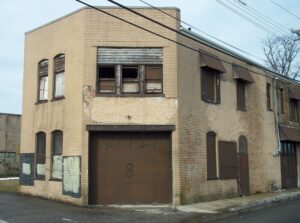
Hot Spot — The old Phil Daly Hose Company #2 firehouse at Broadway and Second Avenue. First organized in April 1886, this city firehouse opened in September 1902 (replacing the 1887 original). Clarence W. Smith designed the $5,000 brick building. Charles N. White was company president for over 40 years. In 1968, the company moved to a new firehouse on Union Avenue, sharing with the Independent Engine & Truck Company, #2. The building fell in 2018 along with many surrounding Lower Broadway structures.
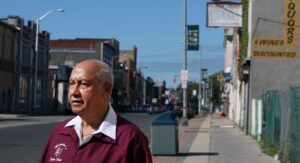
Hispanic Hero — Dimas Montalvo outside his Lower Broadway barber shop, 2000s. Born poor in western Puerto Rico one of 15 children, he came to America in 1955. Starting as a barber at Fort Monmouth, he worked hard and saved his money — opening his first hair cut business on Broadway in 1964. He moved to a larger building in 1969; his shop also had a record store. The business closed shorty before the building was demolished in 2018. Considered a pillar of the city’s vibrant Latino community, Dimas passed away in January 2023.

At the Boardwalk — Where Lower Broadway and Ocean Avenue meet, March 1937. Visible are Long Branch Stadium(l) and the Casino Annex (r).
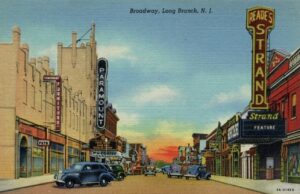
Star Power — Paramount Theatre and Reade’s Strand Theatre on Lower Broadway, 1939. Opened in January 1931, The Paramount (started as the Broadway Theatre in 1912) and The Strand opened in 1924 became The Baronet Theatre (in 1959).
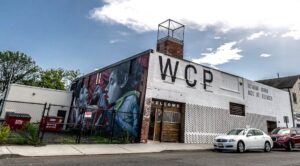
Broadway Brewer — The Whitechapel Projects on Second Avenue, 2019 (Ronald Claiborne Photo). The city’s first brew-pub located just off Lower Broadway opened in December 2018. One of the shore’s premier restaurateurs, Marilyn Schlossbach started the “venue that underscores the art in daily life through food, drink, performance, and events” — MORE INFO.

New Broadway — A first look at Kusher’s $130 million redevelopment vision for Lower Broadway, March 2024. The vision is to “establish a thriving year-round destination by introducing premium residential, retail, and neighborhood services that support the community throughout every season” — MORE INFO.

New Ocean Park at corner of Broadway and Ocean Avenue, 1905. The building above was known as the Casino Annex. It was hit by a major fire in April 1929.

Down Town — Broadway and Memorial Parkway, 2020s (Jersey Shore Aerial Solutions Photo).

That’s Entertainment — Inside the decaying Paramount Theatre on Broadway, 2017. Among the worthies to perform at the city’s playhouse were: Mae West, Al Jolson, Leslie Howard, Barbara Stanwyck, Walter Houston, Jack Haley, Claudette Colbert, Sara Bernhardt, and Bill Robinson. In 1951 the Long Branch Daily Record called the theater “a heritage that may never come again.”
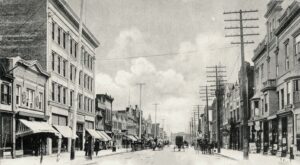
Early Big Box — Broadway looking east, 1910s. Steinbach’s Department Store (the large building at left) was founded by brothers, John and Jacob, in 1873.
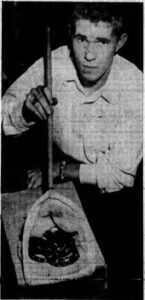
Take A Bite — Charles J. Hornbostel, Jr. with a bagged rattlesnake at the family owned Long Branch Pet Shop, Long Branch Daily Record, October 1955. The business opened on Broadway in 1931. Charles later served as the police chief in Monmouth Beach from 1964 until his death in 1972.
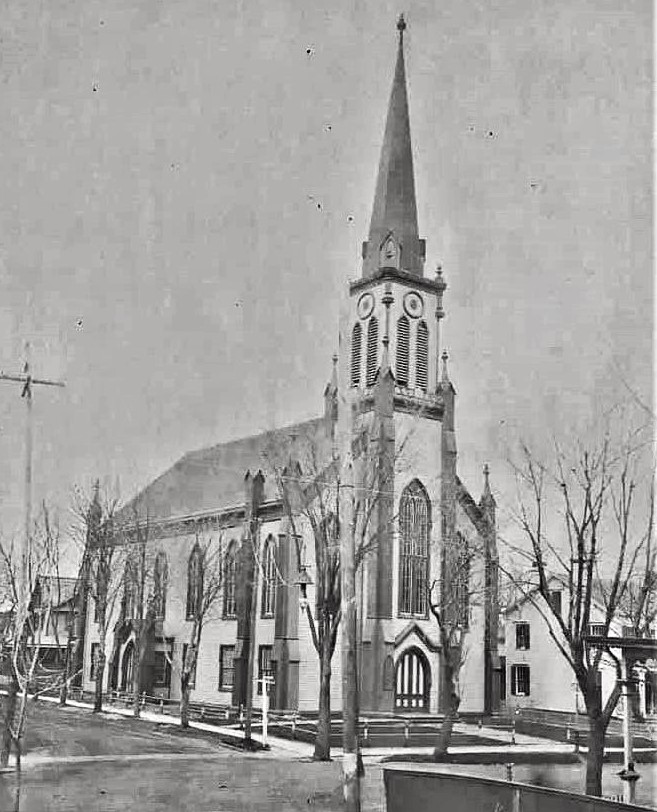
Broadway Heights — The fabulous Centenary Methodist Episcopal Church at the corner of Broadway and Washington Street. Its amazing spire reached 180-feet high. Construction began during the Civil War and was completed for $30,000. The church opened in July 1869 and President U.S. Grant was there for the celebration, according to the Long Branch Daily Record. The LBHS Class of 1879 held its commencement exercises at the church. The house of worship burned and the steeple fell during a January 1893 snow storm. Today, the St. Luke’s Church rests at the location.
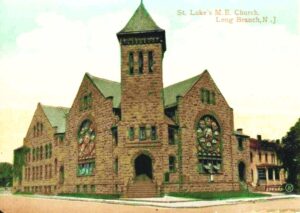
St Luke’s United Methodist Church on Broadway, 1920s. The original church was lost in a January 1893 fire. A new one costing $45,000 opened in 1894, designed by Poole & Sutton of Newark. MORE INFO.
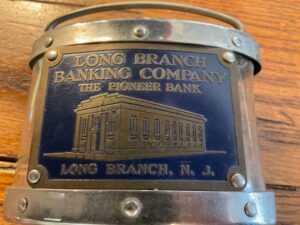
Long Branch Baking Company container. Founded in 1872 on Broadway, President US Grant was one of the first bank directors. It merged with several banks over the years. The building has been the city’s Arts & Cultural Center since 2019.
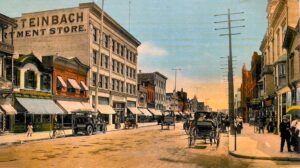
Steinbach’s Department Store on Broadway, 1908. Brothers, John and Jacob, opened the business in 1873.
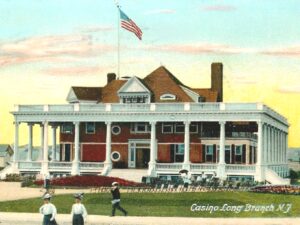
Long Branch Casino Annex in Ocean Park, 1909. The building at Ocean Avenue and Broadway went through many identities in its lifetime. Originally a section from the nation’s Centennial Exhibition held in Philadelphia in 1876. The structure was moved to Long Branch in 1877 probably by Richard J. Dobbins. It was torn down in 1945.

Andy’s Garage on Broadway, 1930s. Andrew Lustbaum — a pioneering city auto dealer and mechanic — started the business in 1908. He was also president of the NJ Auto Dealer’s Association and director of the local motor vehicle bureau. Born in Hungary, he died in August 1953.
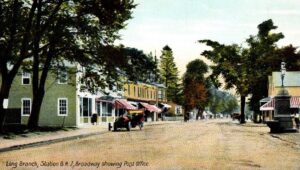
Upper Broadway at Norwood Avenue, 1910. At left is the US Post Office and at right is the Dr. Chattle Monument.
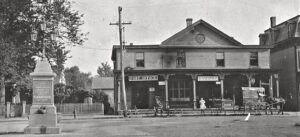
US Post Office on Broadway in Long Branch, early 1900s. William W. Croxson was the first local postmaster from 1834 to 1846.
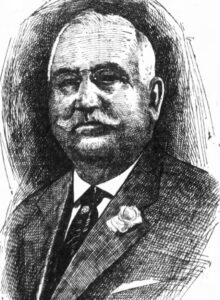
Dean of City Lawyers — Benjamin P. Morris, 1927, was considered Long Branch’s leading attorney in his time. “Uncle Ben” is credited with bringing the first typewriter, telephone and law clerk to his Broadway law office (where he worked for over 25 years). He also served three terms as a Long Branch commissioner and a year as mayor in 1900. The Long Branch native (born in his father Jacob’s seashore hotel in 1857) and 50-year practicing lawyer died in February 1937.
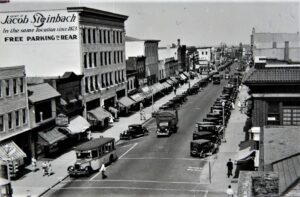
Broadway at Third Avenue looking east, 1935. The Steinbach store closed in 1942 after 70 years in business. Vogel brothers (Abe, George, Herman, Morris) acquired the building and made improvements. The store reopened in November 1945 and operated on Broadway for 30 years.
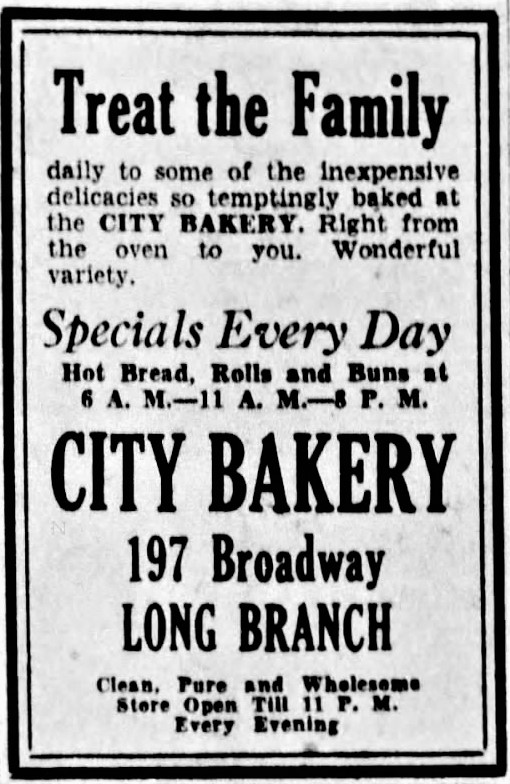
Hot Stuff — City Bakery on Broadway, 1931. Some city residents still rave about the quality of baked items from this long-gone Long Branch institution. Newark native Carl Elenberger started the business in 1924 and operated things until his death in December 1966. The store motto: “Buns are out backbone.”
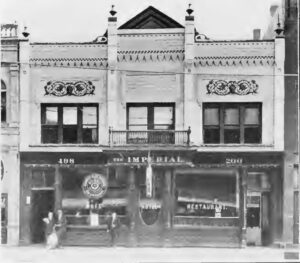
Imperial Hotel on Broadway, 1909. Built for $22,000 by Prussian-born Berthold Sussman and Sons in 1898, the “all year around” hotel offered 25 rooms and a 100-seat restaurant/bar. Daily rates started at $1. Sussman died in Sept. 1911.
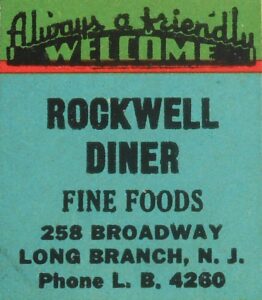
Rockwell Diner ad, 1940s. Originally part of the old Hotel Rockwell and Restaurant at Broadway and Rockwell Avenue that burned in February 1936. It re-opened at a new location with a new $18,000 steel diner in November 1941. Owners then were John Cittadino, Fenwick White and Louis Miller. The diner was moved to near the railroad depot on Third Avenue and became the Station Diner in May 1969. Later it was the called the Branch Coach Diner and Golden Coach Diner before closing in December 1985.
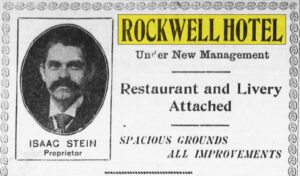
Rockwell Hotel new owner, March 1907. Isaac Stein was owner until 1921; he died in 1937. The business (it had been called Brunswick cottage) was started by Elwood Richardson in March 1892. It burned in 1936.
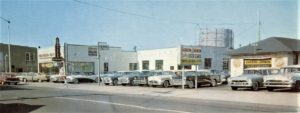
Auto Sale — Barron & Jarmon auto dealers on Broadway, 1940s. There was an age when selling cars in Long Branch was a big business. In 1927 the Long Branch Auto Dealers Association was formed with 15 independent members. By 1957 no less than 10 dealers were selling cars on Broadway. Including: Barron & Jarmon, Finn Buick, McFaddin Motors, Kitson Chevrolet, Jones Motors, Heimlich Motors, Kroll Motors, Ray Forshay, Inc., Towbin Lincoln-Mercury, Al Matlaw Motors, and F&J Motors.
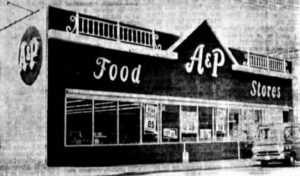
A&P Supermarket at Broadway and 5th Avenue. Long Branch Daily Record, June 1966. The store had just been renovated.
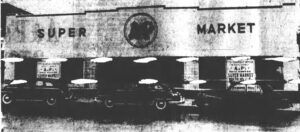
A&P Supermarket on Broadway at the time of its grand opening. Long Branch Daily Record, November 1949. The first “self-service” A&P Food Store to open on Broadway was in Sept. 1938.
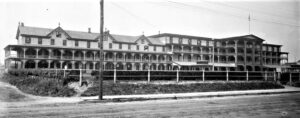
Ocean Hotel, early 1900s. Located at the corner of Broadway and Ocean Avenue, it started as “Cooper’s House” in 1832. The hotel continued to grow and change identities: it was the National House, the Continental Hotel and finally in 1872, the Ocean Hotel. The largest hotel in the nation at the time, it closed in 1902. The city acquired the property in 1905 and turned it into Ocean Park and later Garfield Memorial Park. Today, the Ocean Place Resort & Spa holds the grounds.
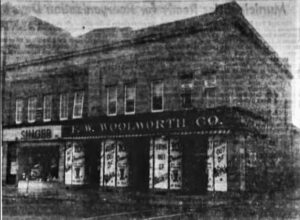
F.W. Woolworth & Company building on Broadway, 1959. After 50 years of operations there, the “5¢ and 10¢ store” shut its doors in December 1959. Sol Grabelle, Ace Drug Store owner, bought the building (Long Branch Daily Record Photo).
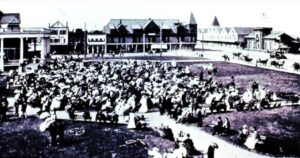
Music from Ocean Park at Broadway and Ocean Avenue, early 1900s. In the background is the Lenox Hotel and note the amazing architecture across the street.
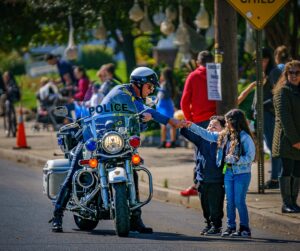
Italian Pride — Long Branch Columbus Day parade on Broadway, October 2022. The first city parade to honor the Italian explorer took place in 1909. Rocco “Rocky” Bonforte, the city’s postmaster from 1963 to 1975, chaired the parade committee from 1952 to 1974. He was also a city cop and a commissioner. During the 1960s, according to US Census data, Italian-Americans were the city’s largest ethnicity.
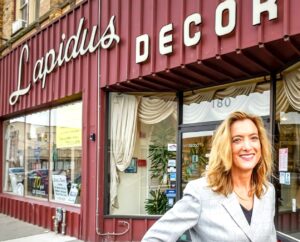
Broadway Style — Lapidus Decor on Broadway with owner Holly Lapidus, 2017. Her parents, Seymour and Ruth, started the business in 1946 first operating out of a jeep with trailer and moving to its current location in 1974. Holly joined the custom interior decorating business in 1982. Seymour, a Brooklyn native and US Army WW II vet, died in April 2008. Long Branch native Ruth passed away in 2015 — MORE INFO.
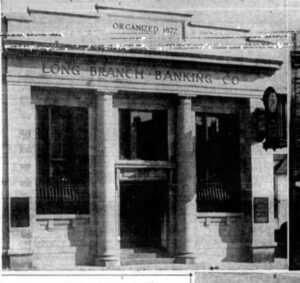
Long Branch Banking Company on Broadway, 1951. Opened in May 1873, William Maps was the first bank president. It later became a number of other banking-financial institutions over the years. In 2019, the building was donated to the city and is now the Long Branch Arts & Cultural Center and Office of Community & Economic Development. MORE INFO.
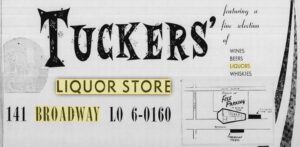
Booze & Bras on Broadway — Tucker’s Liquor Store ad. Long Branch Daily Record, December 1956. Harry Tucker started the Broadway business in December 1933 — becoming first in the city to receive a retail liquor license after the repeal of Prohibition. He came to Long Branch in 1916 starting with a clothing store which his wife and daughter (Ruth and Blanche) grew into a popular corset and lingerie shop — all in the same Lower Broadway building. Born in Russia, Harry died in October 1954. His son, Jerome (who earned two Bronze Stars for the US Navy in WW II and was 1959 city chamber of commerce president), later ran the liquor business. He died in 2015.
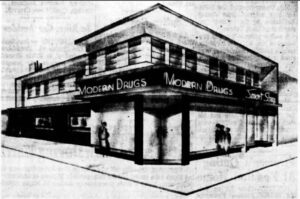
Tuttman Building at Broadway and Third Avenue redesign plans. Long Branch Daily Record, August 1948. James Mancuso was the architect and Charles Schulz was the contractor. The location previously held Liggett’s Drug Store.
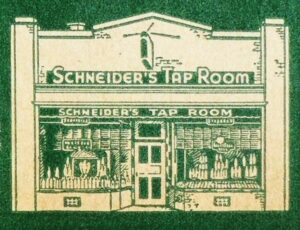
Schneider’s Famous Tap Room ad, 1940s. Lithuanian-born Isidor “Izzy” Schneider started the Lower Broadway restaurant in 1933 — with just a bar and five tables — and grew it into a city landmark before selling in 1966. It all burned in 1992.
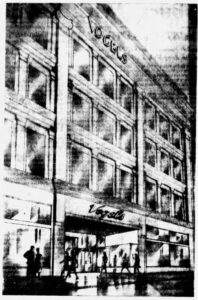
Vogel’s Department Store on Broadway sketch, Long Branch Daily Record, January 1947. Opened in Fall 1945, it was run by second generation furriers, Abe and George Vogel. Their father, Israel, had first opened a Broadway shore in 1918. The business shut in 1975 and the building burned in 1978.
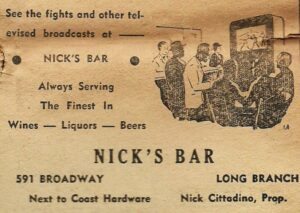
Nick’s Bar on Broadway ad, 1947. Italian-born Nicholas Cittadino opened the business in the late 1920s (first as Norwood Restaurant & Deli) and ran it until his death in March 1953. Later his family and the Mazza family were owners and ran it up to the 1970s.
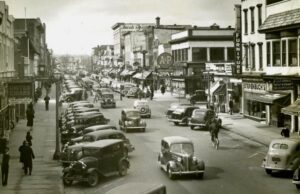
Broadway looking west, 1940s (NJ State Archives Photo).
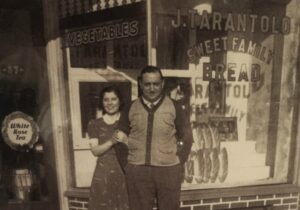
Tarantolo’s Bakery on South Broadway, 1930s. Joseph and Mary Tarantolo started the business in June 1923. Born in Sicily, Joe retired in 1958 and passed away in October 1982. His son, Gerald, was a longtime Eatontown mayor. Frank Sorrentino, once a WLB mayor, also was an owner of the bakery.
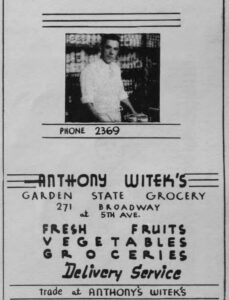
Anthony Witek in his Garden State Grocery at Broadway and 5th Avenue, 1936. A city native and proud World War I Army vet, he died in February 1967.
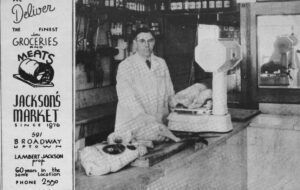
Jackson’s Market on Broadway, 1936. One of the city’s oldest businesses was opened in 1876 by Lambert W. Jackson and later run by his son, Ellsworth and grandson, Lambert K — who retired in December 1951. It would become the late great Freddie’s Pizzeria.
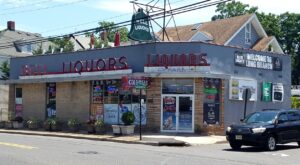
Bell Liquors on Broadway, 2019. Martin Becker opened his first liquor store on lower Broadway in 1944. By May 1957, he’d moved operations uptown and made it “Monmouth County’s largest liquor store.” Becker held the fort — enduring several armed robberies as reported in the local papers — for 40 years before selling in 1984. The New York native died in May 2001.
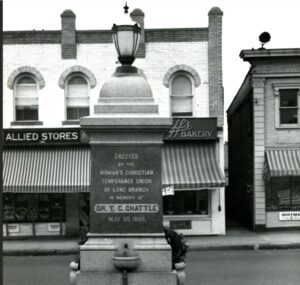
Dr. Thomas C. Chattle “temperance” memorial monument when it was on Broadway between Norwood and Bath Avenues, 1940s. Dedicated in May 1899 to the longtime city superintendent of schools, the structure previously included a water fountain. Considered a “traffic hazard,” it was moved to City Hall property in October 1978 and later to the high school property. Dr. Chattle died in 1889.
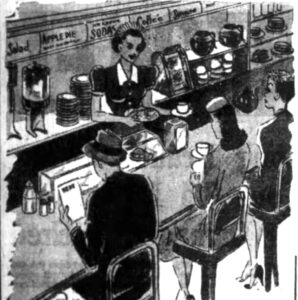
Sketch of J.J. Newberry, Co. Luncheon Bar, Long Branch Daily Record, Sept. 1944. The Broadway nickel-and-dime store opened in July 1939 and closed in 2002. The 50-foot dining counter was made of marble and steel. The luncheonette was renovated in May 1965.
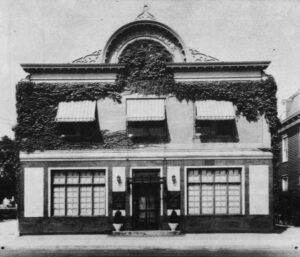
Flock Funeral Home on Broadway, Fall 1936. Opened in 1903 (as Hyer & Flock), John W. Flock took full control in 1911. Both a Long Branch mayor and Monmouth County coroner, Flock died in 1952. John, Jr. ran the business until his death in 1997. In 2015, it became the Lawson Funeral Home.
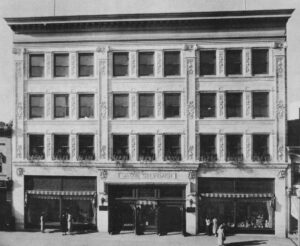
Steinbach Department Store on Broadway, 1936. “A new store with an old reputation” — opened in 1873 by brothers, John and Jacob. In 1893, Jacob assumed full control and ran it until his death in 1933.
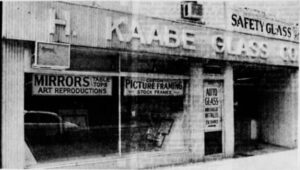
H. Kaabe Glass Company on Broadway, 1976. Henry Kaabe opened his Broadway store in 1920. Born in Lithuania, he moved to Long Branch in 1910. After his death in May 1973, sons Louis, Max and Ben ran the business.
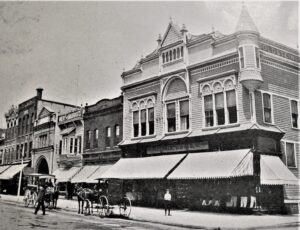
Goldstein & Son Department Store on Broadway, 1910s. Joseph Goldstein opened the store in 1883. Born in Austria, he sold the business in 1928 and died in January 1937.
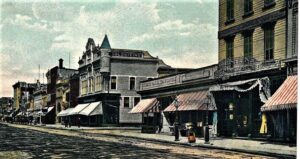
Goldstein’s Department Store at Broadway and Liberty Street, 1910 (Raymond Storey Photo). “One of the most modern department stores in the country” –APP, June 1928.
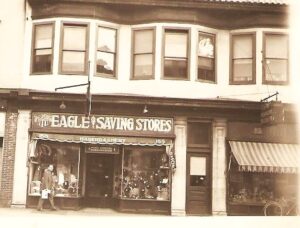
Eagle Saving Stores on Broadway, 1940s. A classic “Haberdashery” — later it was Eagle Men’s Store — it operated until the 1970s. Romanian-born Morris Friedman started the business and worked there with his son, Sol. Morris died in July 1972.
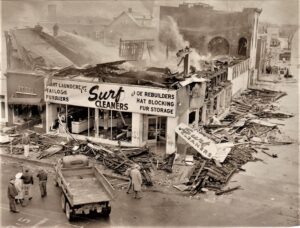
Surf Cleaners at Broadway and Liberty Street in ruins after a fire, March 1956. Milton Feldheim opened the dry cleaning business in September 1954. The building was once the S. Goldstein Department Store.
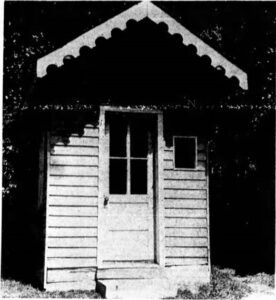
Broadway Turnpike tollbooth, Long Branch Daily Record, August 1961. By the mid-1830s, Long Branch was largely divided into two sections: Upper Village and Lower Village. To pass from one section to another along Broadway required paying a 2 -cent fare. After much citizen protest, the booths were removed in 1875 when the LB Commission bought the road’s charter.
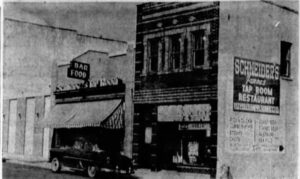
Schneider’s Tap Room & Restaurant, 1940s. Isidor “Izzy” Schneider opened the Lower Broadway business in 1933 starting with just a bar and five dining tables. It proved very popular and expanded. The Lithuanian-born Schneider sold the business in 1966 and died in July 1983.
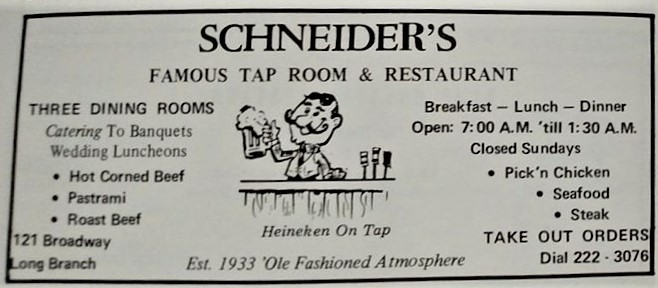
Schneider’s Famous Tap Room on Broadway ad, 1970s. Abe Wolotsky and Harold Sawyer took over the business in 1966. Jack Murphy bought the business for $150,000 in 1978. It was “Hunter’s Run” — a nude go-go bar serving fruit juice run by John Evichin in May 1988. The building was hit by a fire in July 1992.
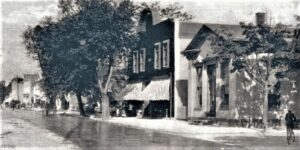
Scene at Broadway and Branchport Avenue looking west, 1872. Later on the Long Branch Banking Company opened on the corner.
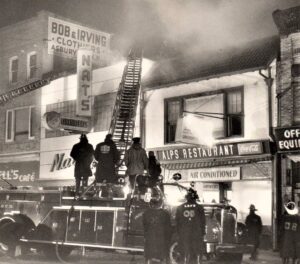
Fire on Broadway, March 1959. Nat’s Jewelers (owned by Nathan Lubitz) and Alps Restaurant (owned by Edward Ward) were damaged in the pre-dawn blaze.
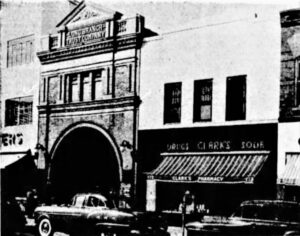
On Broadway … Clark’s Pharmacy (r) and the Long Branch Trust Company (l), 1953. Harlo A. Clark bought the drug store in October 1924 (it had been Wert’s Pharmacy). It moved to Oakhurst in 1953. A city native and 1921 Columbia University University College of Pharmacy graduate, Clark died in 1973.
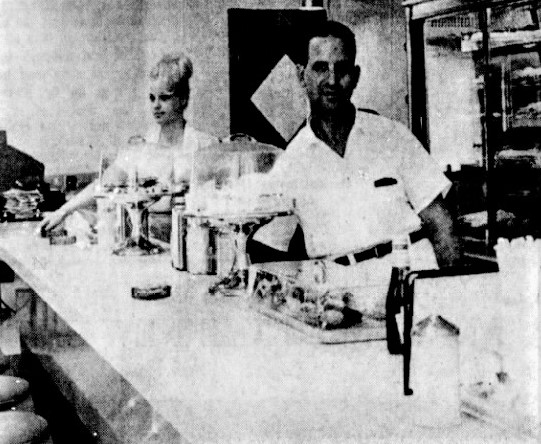
Blue Crystal Restaurant at 553 Broadway. “Charcoal Broiled” was the specialty at the popular eatery. Opened in September 1964, Lewis Travlos (r) was the owner — he ran the business with his wife Diana until retiring in 1985. Born in Greece, he served in the US Army in WW II; he died in April 2005. Diana passed in 2003.
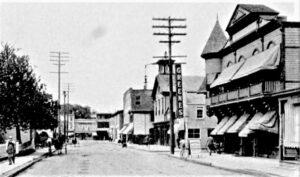
Greene’s Hotel at Broadway and Third Avenue, 1909. Charles H. Greene, Jr. was the owner. George Tindall acquired the hotel in 1917.
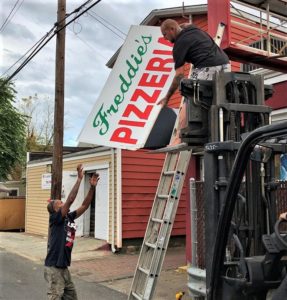
Freddie’s Pizzeria sign comes down, October 2019. Italian native Fred Scialla started the restaurant in 1944 and moved to its familiar location on Broadway in 1952. In February 1995, Mark Brockreide, a cousin, acquired the “thin-crust pizza” landmark and ran it ably for some 25 years. Today, the spot is Lezama’s Restaurant and Pizzeria (Jack Flaherty Photo).
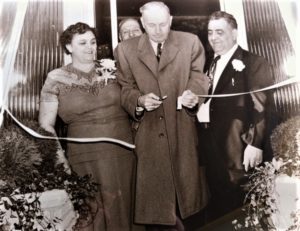
Grand Opening of Freddie’s Restaurant & Pizzeria on Broadway, 1944. In 1952, the eatery moved across the street into the old Jackson’s Market building. Freddie’s closed in 2019.
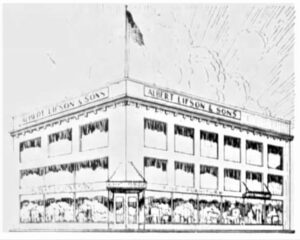
Albert Lifson & Sons at Broadway and Liberty Street. The Russian-born father and three sons brought their furniture store chain to Long Branch in Spring 1928. The family business started in Elizabeth in 1893. Shortly after Albert died in May 1932, the store went bust.
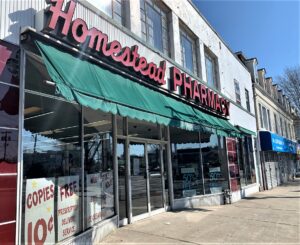
Homestead Pharmacy on Broadway, 2019. Originally Britton’s Drug Store, Angelo Vasiliades assumed control in 1942. He renamed it and then built a new $140,000 building in 1954; he expanded again in 1964. Born in Greece, he was a 1930 graduate of the Columbia University College of Pharmacy. He sold the business in 1972 and died in June 1988.
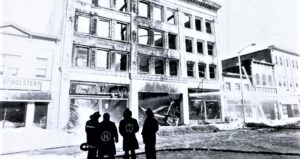
Steinbach’s Department Store on Broadway is nothing but a shell after a major fire, January 1905. “The biggest fire in Long Branch history, ” according to the Long Branch Daily Record, took “one of the foremost department stores in the county” — doing $300,000 in damages.
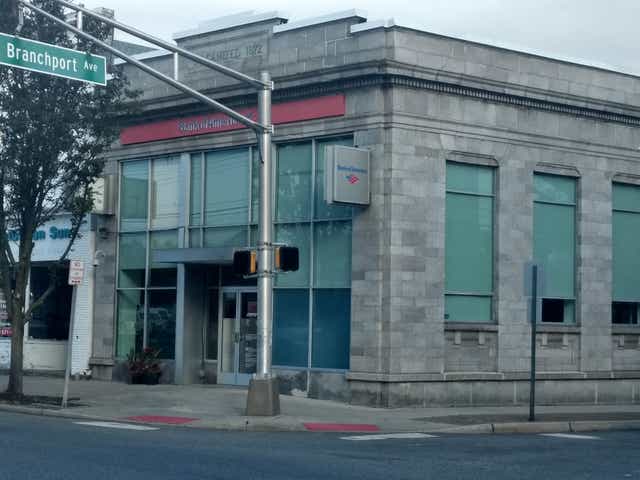
Old Long Branch Banking Company building on Broadway and Branchport Avenue, 2019. Built in 1872, it later became the Central Jersey Bank & Trust Company and finally a Bank of America branch. The building was donated to the city in 2019 and now houses its Arts & Cultural Center and Office of Community & Economic Development.
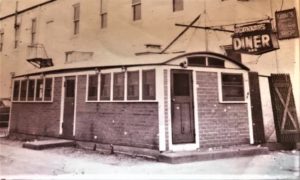
O’Connor’s Diner at Broadway and 7th Street, 1940s. Little Silver native Joseph O’Connor took over the business in 1956; he died in March 1969. Previously, it had been the Broadway Diner owned by Chicago native Bill Krzan who died in August 1951 having just celebrated 25 years in business.
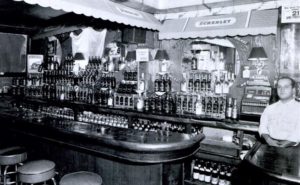
The names of Nicholas and Peter Cammarano (sometimes Joseph Catalano) fill the local newspaper archives as to ownership and activity about a Broadway bar, tavern or grill — going back to 1937. The record is confusing. In later years, Marie and Michael Cammarano were the proprietors; she died in 2011 and he died in 1973. (Note: In 1954, according to the LB Daily Record, the Cammarano family was operating three city bars — on Broadway, Joline Avenue and Kensington Avenue. They also ran the Sportsmen’s Bar at Long Branch Stadium along the oceanfront). By 2000, the Broadway bar had closed and was replaced by Uptown Restaurant.
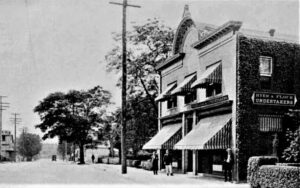
The Hyer & Flock funeral home on Broadway, opened in 1903. The partnership ended when Trevonion Hyer got sick in 1907; he died in 1911. John W. Flock then took full control — he had been in the undertaker’s business since 1896. In 1920, Flock also established the Woodbine Cemetery in Oceanport. John, Sr. was a prominent man – a former LB mayor and Monmouth County coroner. He also served on the board of directors of the NJ Trust Company, Monmouth Park and the LB Housing Authority. He died in 1952. John, Jr. took control in 1946 and ran the business until his death in 1997. Steven Lawson acquired the business in 2015.
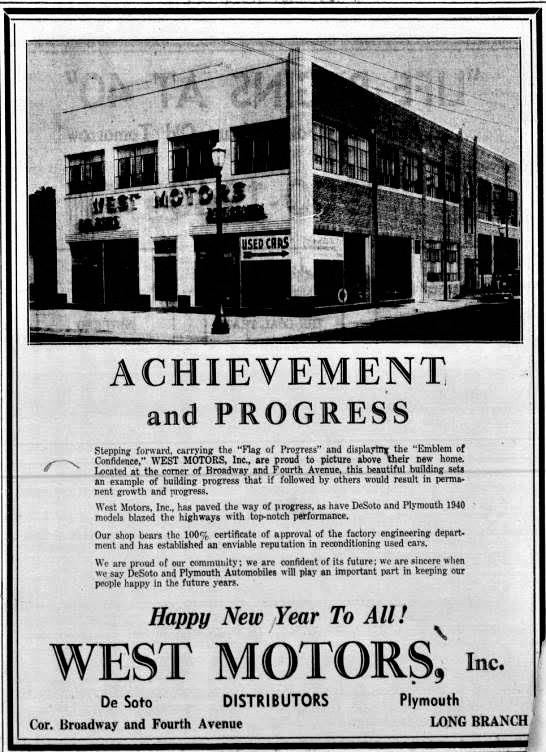
West Motors on Broadway and Fourth Avenue ad. Long Branch Daily Record, 1940. It was housed in the C.W. Jones building which opened in 1938.
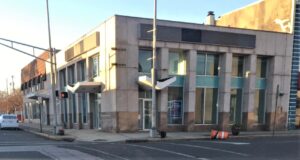
Old New Jersey Trust Company of Long Branch Main Office on the corner of Broadway and Memorial Parkway, 2020. The bank opened in 1905.
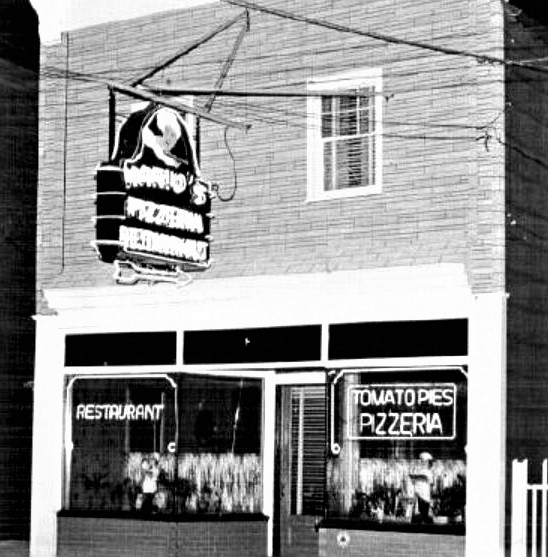
Mario’s Restaurant at 574 Broadway, 1960s. Opened in 1930, the pizza was considered among “the city’s best.” The business closed in 1969.
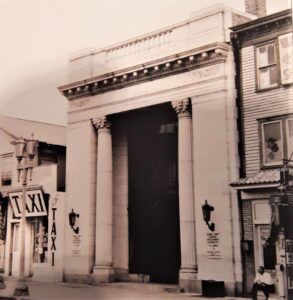
Citizen’s National Bank — in its Neoclassical style at Broadway and Third Avenue, 1920s (Long Branch Public Library Photo).
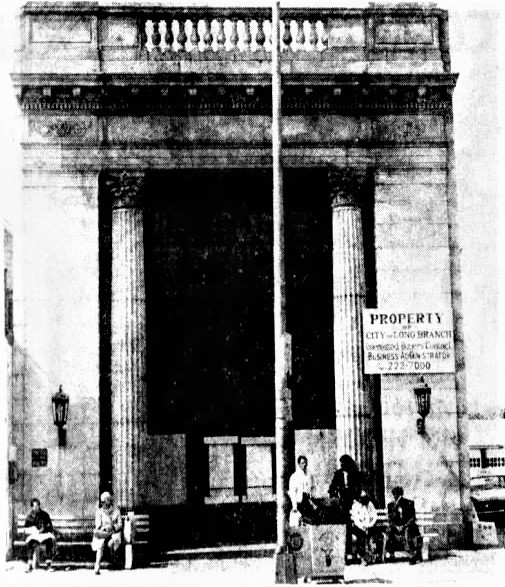
The old Citizen’s National Bank at Broadway and Third Avenue, May 1972. The ornate stone bank building opened in March 1899 and closed amidst the Great Depression in December 1931.
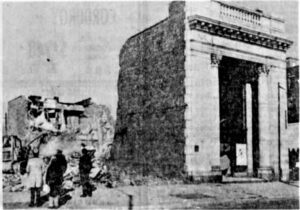
Demolition of the old Citizen’s National Bank, December 1976. The city took possession of the building in a 1971 foreclosure.

Lenox Hotel (r) at the corner of Broadway and Ocean Avenue, early 1900s. John W. Wilson first got involved with the property in 1908 when he came down from NYC. When he died in July 1942 he had a stake.

L.D. Edwards Company on lower Broadway. Aaron Edwards started the coal and lumber business and ran it with his brothers, operating from 1877 to 1909.
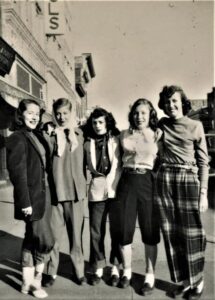
“Five Friends” outside Alps Kandy Shoppe on Broadway, 1950s. They offered store-made candy and ice cream.
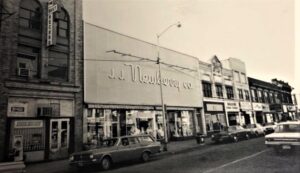
J.J. Newberry, Co. store on Broadway, 1960s. When the store first opened in July 1939, it offered 27 shopping departments and a 50-foot luncheon counter — all staffed by 67 city employees.
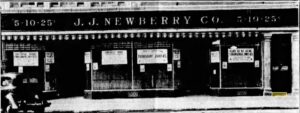
J.J. Newberry front, 1939. John Roberts was the first manager. The store closed around 2002; today it’s a Family Dollar Store.
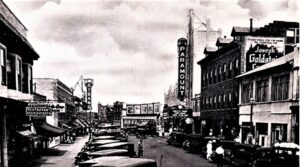
Competing theaters on Broadway: The Paramount (r) and The Strand (l), 1930s. The Paramount had previously been the Broadway Theatre (opened in 1912). Built by Walter Rosenberg (who later became Walter Reade), it was reopened in 1931 as Paramount and operated until Sept. 1959.
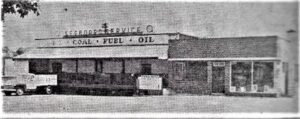
Seaboard Service Company at 400 Broadway, 1953. The new ice, coal and fuel oil plant seen above opened in June 1948 with Charles Presley as manager and H. Cornell Kahle as president. The business was started in 1927 by C. Raymond Shelley; he died in 1937. Abraham Kruman acquired the company in 1949.
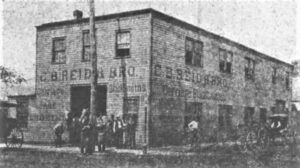
C.B. & I.P. Reid Carriage Shop and Blacksmith on North Broadway. Long Branch Daily Record, April 1908. The business opened in 1877.
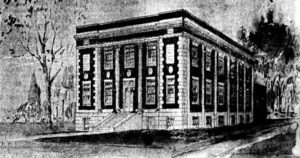
Long Branch Masonic Temple sketch proposal, Long Branch Daily Record, June 1925. The lodge opened in March 1926 at 410 Broadway. It cost $136,000 — Leon Cubberly was the architect and Edward Schoenthaler was the builder. At the time, Dorman McFaddin was club president and Ralph Lum was Grand Master. Local Freemasons sold the “Corinthian columned” building to Joseph Wenning in June 1981 for $41,000.
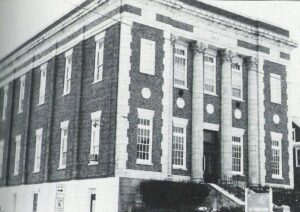
Long Branch Masonic Temple, 1960s. Designer Leon Cubberly, who was a temple member, also designed New York Times building in Manhattan, the Steinbach Building on Broadway in Long Branch, the Monmouth County Hall of Records, and the Marlboro State Hospital. A Long Branch native, he died in June 1968.
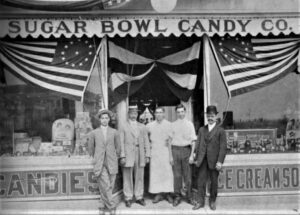
Sugar Bowl Candy Company at Broadway and Third Avenue, 1908. James and Peter Apostolakos ran the business. It closed in 1924
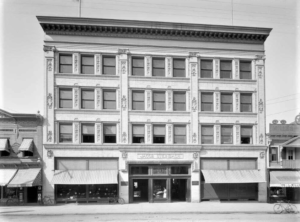
Steinbach’s Department Store on Broadway, 1905. The store was founded by brothers, John and Jacob, in 1873. By 1893, Jacob had assumed full control of the LB store and ran it until his death in 1933. Retail business stopped there in April 1942 and the US Signal Corps then leased the building for a couple of years.
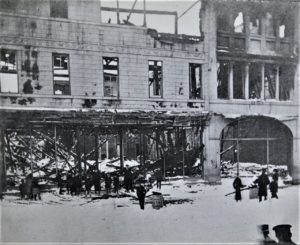
Steinbach’s Department Store in ruins after major fire, 1905. It was rebuilt that same year. Owner Jacob Steinbach was born in Bohemia and moved to Long Branch in 1867. His first store was on Ocean Avenue.
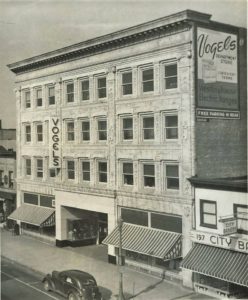
Vogel’s Department Store on Broadway, 1940s. The business was acquired in 1944 by Abe and George Vogel, second generation furriers who learned the trade from their father, Israel Vogel, who first opened a Broadway shore in 1918. Vogel’s closed in 1975 and the building burned in 1978..
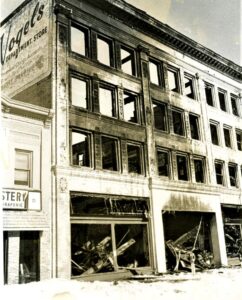
Vogel’s Department Store in ruins after fire. February 1978. First opened in 1873 as Steinbach’s Department Store founded by brothers, John and Jacob. By 1893, Jacob assumed full control of the LB store and ran it until his death in 1933.
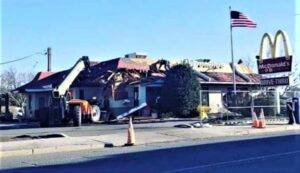
Long Branch McDonald’s undergoing a remodeling, 2021. The Broadway fast-food franchise was first opened in August 1983 by Ernie George, a former music teacher and professor in NYC. The New Orleans native died in May 1997. The renovated shop reopened in April 2021.
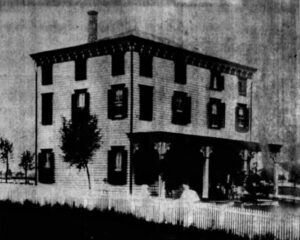
Home of Edward R. Slocum on Broadway in 1868. Today, it’s the location of the city’s public library. Long Branch Daily Record, 1964.

Brookdale Community College annex on Broadway, 2000s. The Long Branch Learning Center opened in 1980 at the site of the old Vogel’s building that was wrecked by fire in Feb. 1978. Monmouth County’s community college has its main campus in Lincroft.
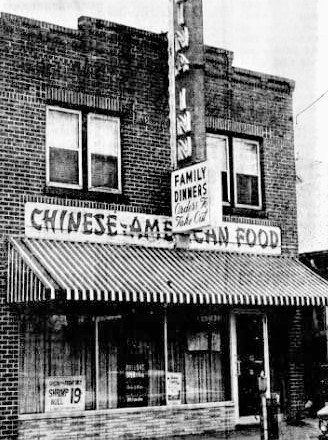
The China Inn, 1964. The Broadway restaurant was opened in in 1959 and moved across the road in 1965. Jui Yung “Jimmy” Liu was the owner. The China native came to America in 1949.
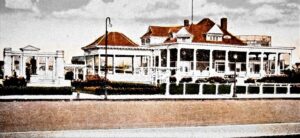
Fabulous shot of Ocean Park fronting on Ocean Avenue, 1920s. From left: Garfield monument, bandstand and Casino Annex. All have been moved or wrecked.
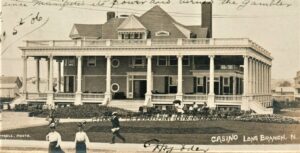
Casino Annex in Ocean Park, early 1900s. A majestic building where the city’s two greatest boulevards meet. It was torn down in 1945.
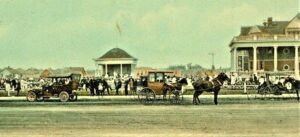
Ocean Park, 1910s. In July 1929, Will H. Pawson of NYC put forward a proposal to build a $3 million hotel and 600-car parking garage on the Ocean Park property in exchange for a 99-year lease at $1 per year. And some 3,000 city voters backed the plan by a 8 to 1 count that August. By 1932, Pawson had “faded out of the picture.”
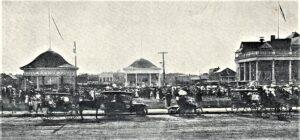
Ocean Park, 1910s. In 1904 a new form of city government, according to the Long Branch Daily Record, approved $400,000 in bonds to make beach front improvements, including Ocean Park.
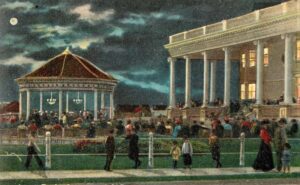
Casino bandstand in Ocean Park, early 1900s. The grounds included 750-feet of prime oceanfront property.
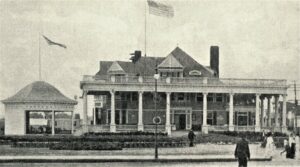
Ocean Park, early 1900s. The Casino Annex had once been the Agricultural Hall at the Centennial Expo at Philadelphia in 1876, according to Entertaining a Nation.
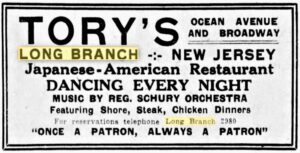
Tory’s Restaurant ad. APP, July 1927. Tory Kawamoto, a Japanese native who came to America in 1904, leased it for $1,500/year and ran a very popular eatery starting in 1925. It burned in a suspicious April 1929 fire. He operated another Tory’s Restaurant on Monmouth Road in WLB since 1924. Worried about his business and the WW II conflict, Tory committed suicide outside Hazard Hospital in October 1942.
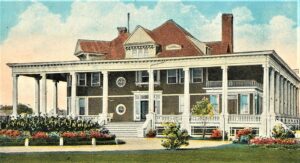
Tory’s Restaurant, 1920s. Located at South Broadway and Ocean Avenue, the building was previously the city-owned Casino Annex. The spot was previously the Ocean Club run by Robert J. Slater for many years.
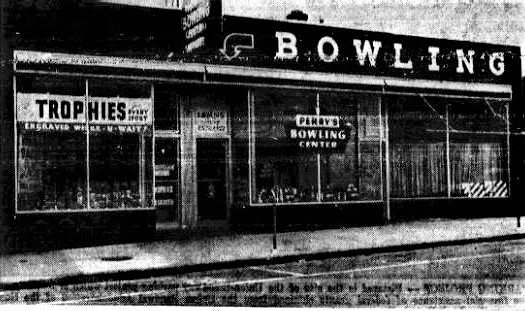
Perry’s Bowling Center on Broadway, 1960s. James “Chitty” Perri opened his first bowling alley (and pool hall) on Morris Avenue in 1924 and moved the operation to Broadway in Sept. 1939, which included 8 lanes. A city native, he retired in 1966 and died in 1995. His son Steve, a decorated B-17 ball turret gunner in WW II, also ran the business. The bowling alley burned in Jan. 1956.
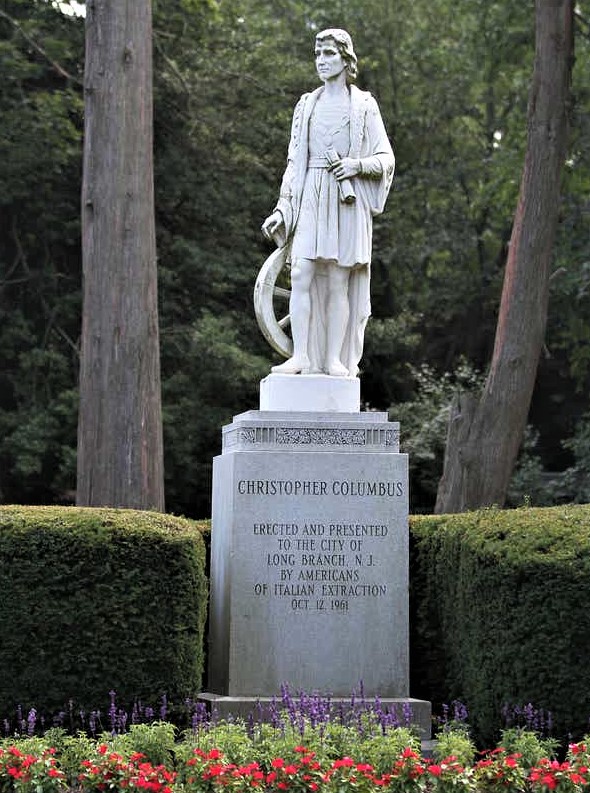
Christopher Columbus monument in Long Branch. The 6-foot statue is located in Slocum Park and was dedicated in October 1961. The marble statue cost $5,000 and was purchased in Carrera, Italy. Ralph Damiano chaired the monument committee. The city’s first Columbus Day parade took place in 1907.
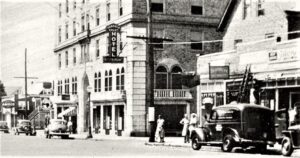
Garfield-Grant Hotel front at Broadway and 5th Avenue, 1930s. Opened in 1926, today the building houses businesses and courtrooms.
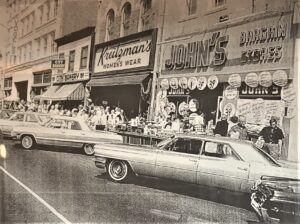
John’s Bargain Store, 1960s. The business opened on Broadway in August 1960; Samuel Teicher owned the building. It closed in 1974.
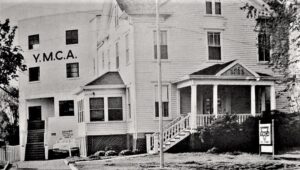
Long Branch YMCA on Broadway, 1968. This local chapter was first organized in 1902, disband and was revived in 1927. Led by E.R. Slocum, the group acquired their Broadway property in 1937. In made a big addition in 1952. Later it become part of Seashore Day Camp.
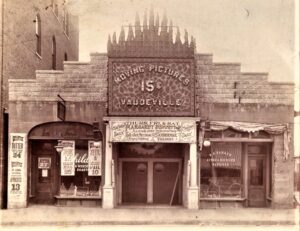
The old Broadway Theater. Opened in June 1912. Among the stars to perform in Long Branch were: Mae West, Al Jolson, Jack Haley, George Jessel, Claudette Colbert, Barbara Stanwyck, Sarah Bernhardt, Walter Houston, Bill Robinson, Morton Downey, and Leslie Howard, according to a 1951 LB Daily Record story. Later it was called the Paramount Theater.
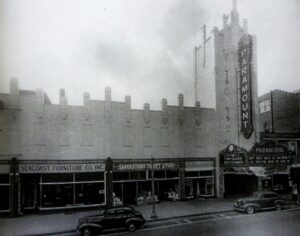
Paramount Theater on Broadway, 1943. Opened first as Broadway Theater by Walter Reade in 1912 and reopened a Paramount in 1931; it closed in 1959. Used for decades as storage by Siperstein’s Paints, it was torn down in 2017.
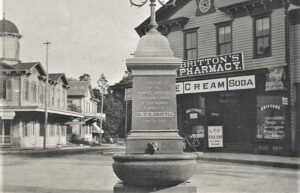
Britton’s Pharmacy at Broadway and Norwood Avenue, early 1900s. John T. Britton established the drug store in 1867. When the family sold the business in 1943, it was the oldest pharmacy in the state.
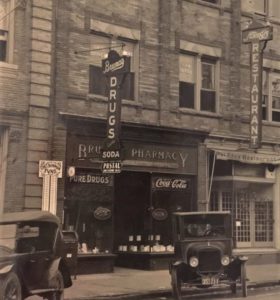
Bruno’s Pharmacy at Broadway and Second Avenue, 1910s. Owner Basil Bruno was a city native. A Republican, he also served on the LB city commission (1948-1952) and represented Monmouth County in the NJ State Assembly for three terms in the 1920s and 30s. A 1910 graduate of the New Jersey College of Pharmacy, he died in 1955.
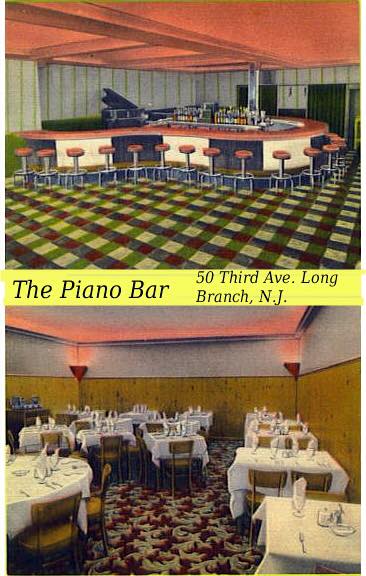
The Piano Bar was on Third Avenue between Broadway and Belmont Avenue. It opened in December 1951, offering “choice cuisine and fine music every night.” Nancy and Pasquale “Pat” Simonetti ran the business. Her father was Vito Genovese, one of the most powerful Mafia bosses of his day. The business closed in 1962.
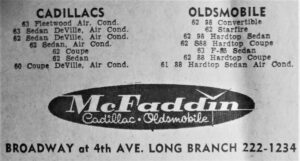
McFaddin Motors ad, early 1960s. It started out as McFaddin’s Garage on Broadway by Dorman McFaddin, Sr., who was a LB mayor as was father Charles O. McFaddin.
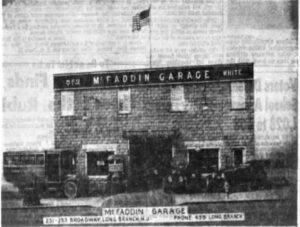
McFaddin’s Garage on Broadway. Long Branch Daily Record, 1912. The shop became the city’s first Cadillac auto dealer in 1916.
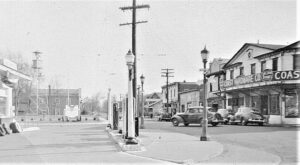
Coast Hardware (r) on Upper Broadway, 1943. Arthur Harmon started the hardware business in 1939; Rich Eyerman acquired it in 1989.

Sketch proposal for new Coast Hardware Co. building at Broadway and Norwood Avenue. Long Branch Daily Record, August 1945. The original hardware store was opened by Art Harmon in 1938 up the road at the bank location.
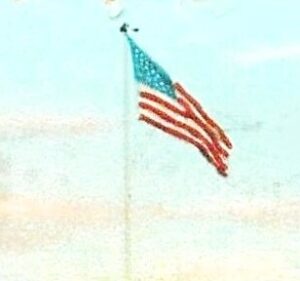
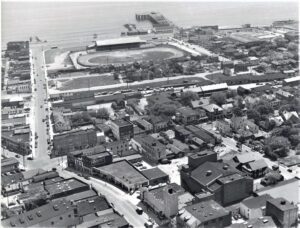
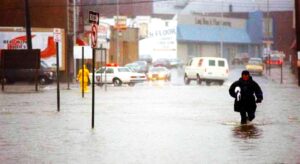
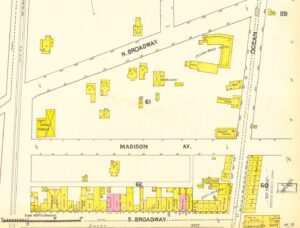
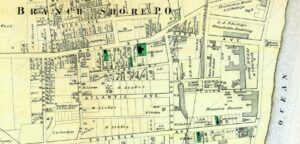
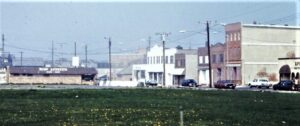
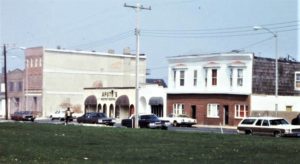
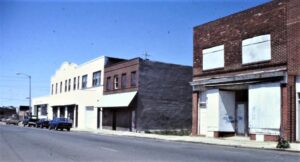
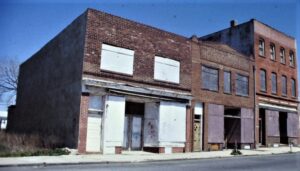
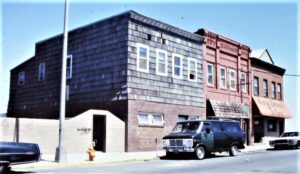
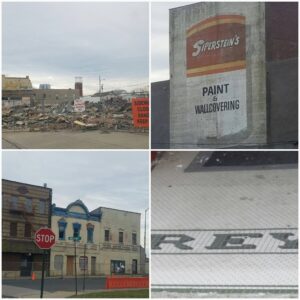
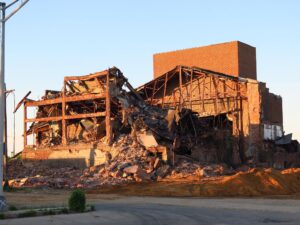


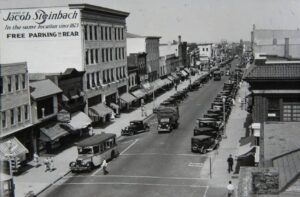
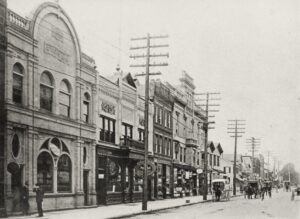
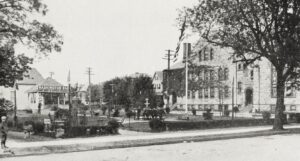
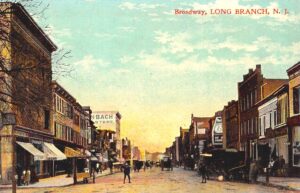
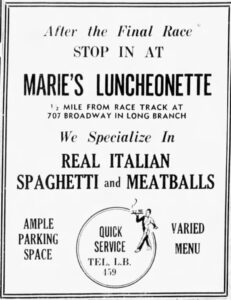

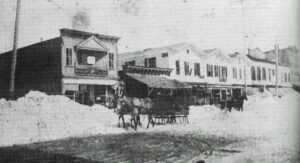
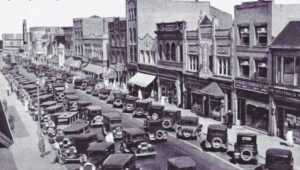
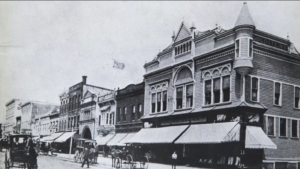
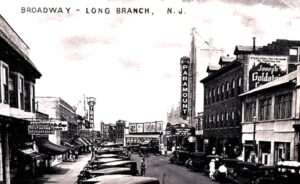
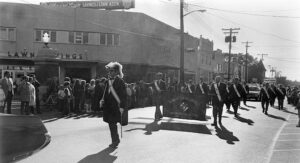
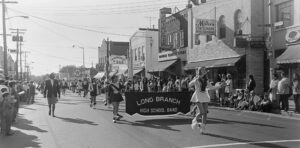
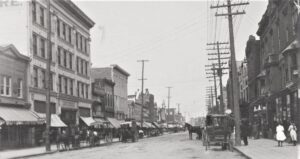
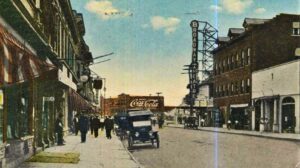
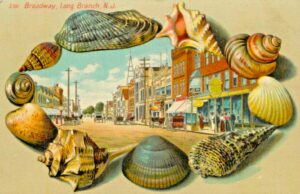
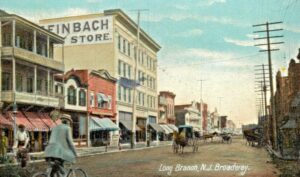
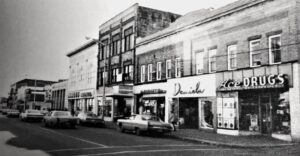
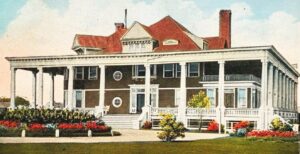
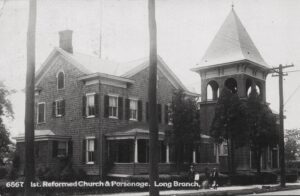
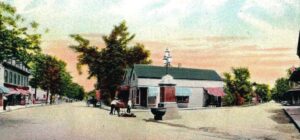
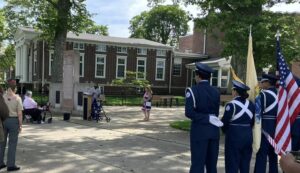
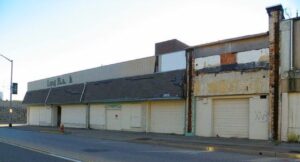
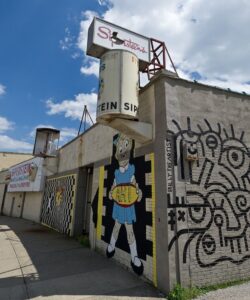
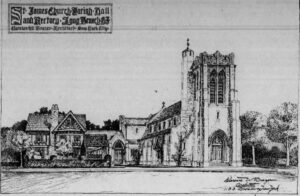
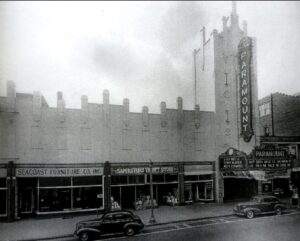
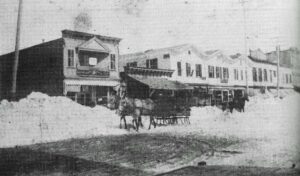
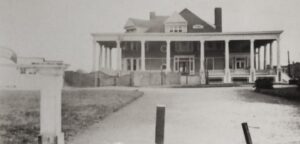
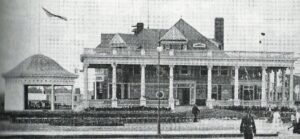
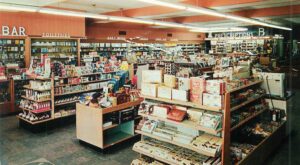
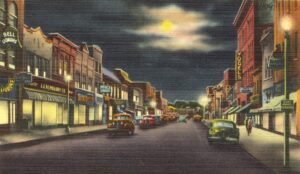
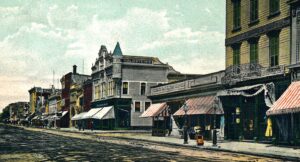
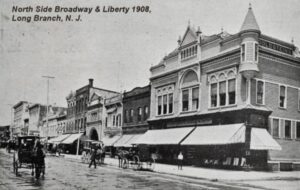
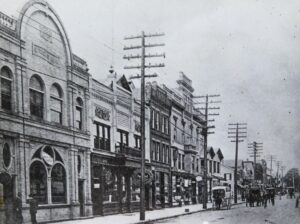
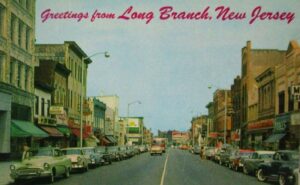
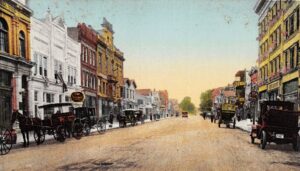
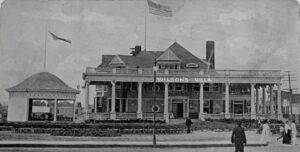
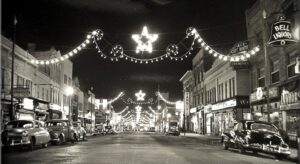
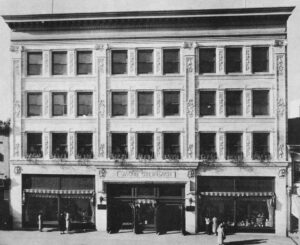
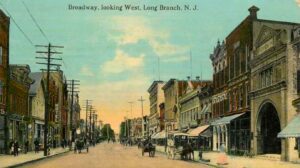
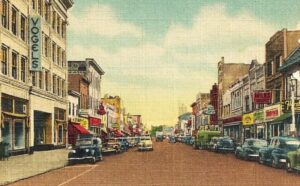
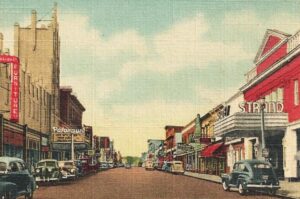
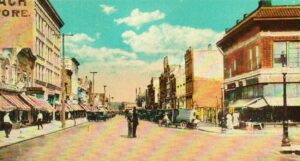
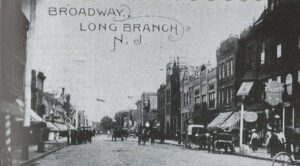

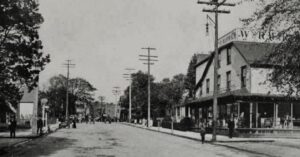
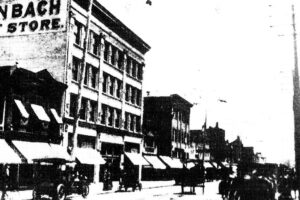
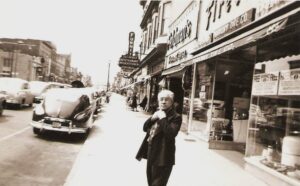
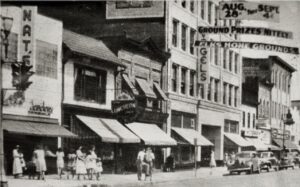
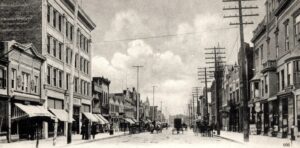
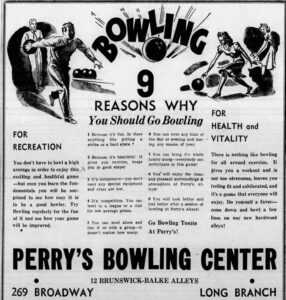
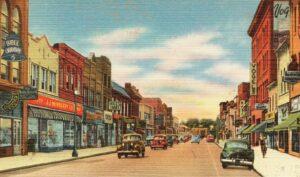
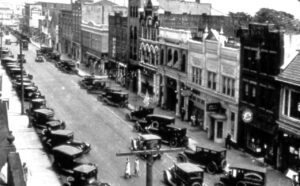
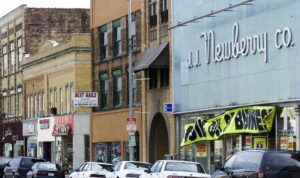
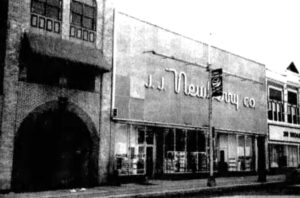
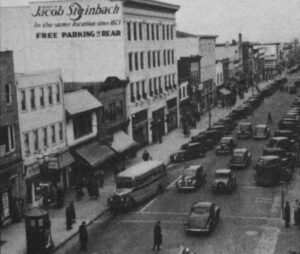
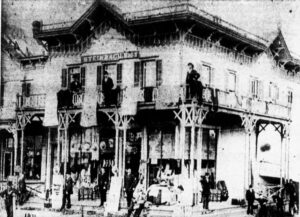
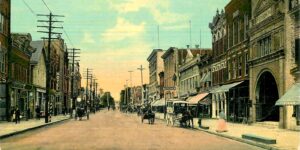
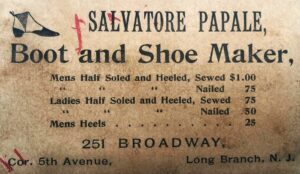
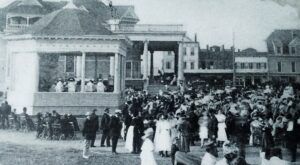
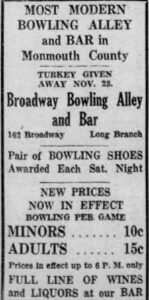
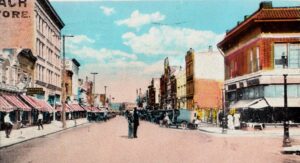
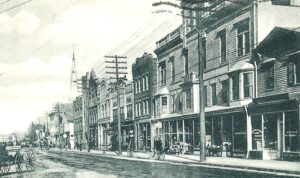
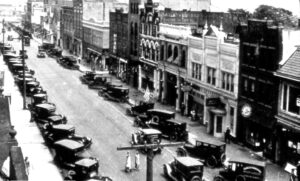
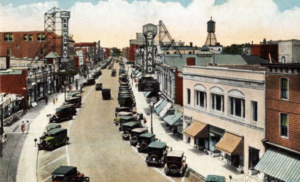
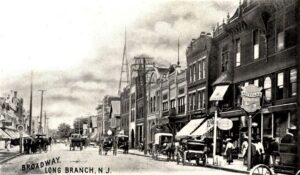
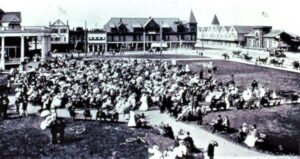
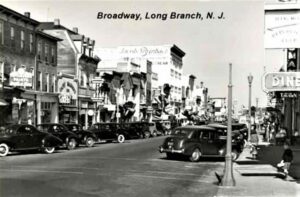
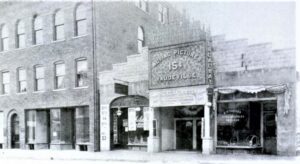
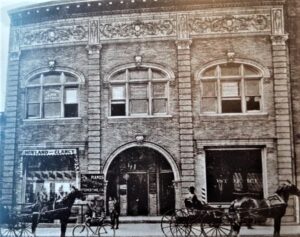
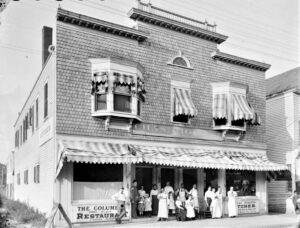
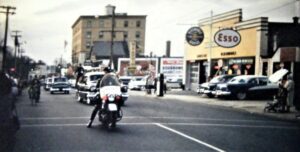
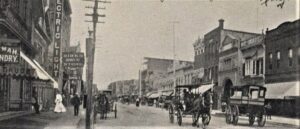
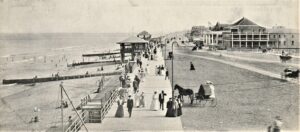
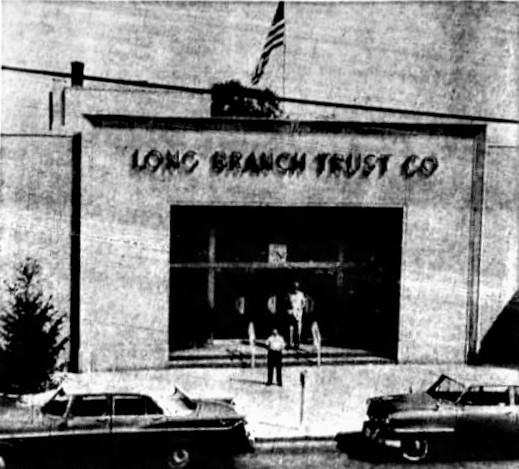
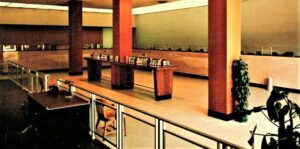
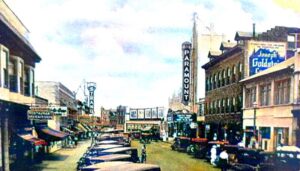
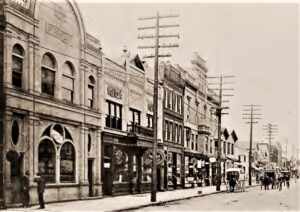
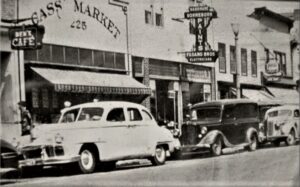
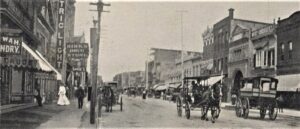
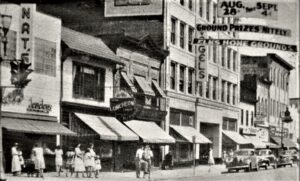
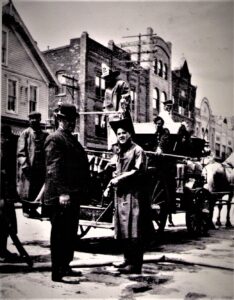
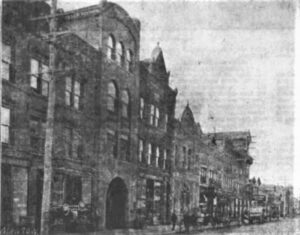
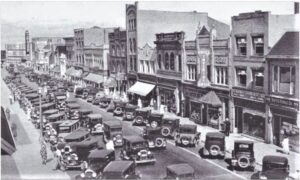
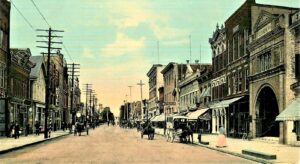
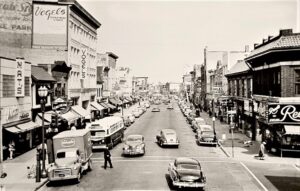
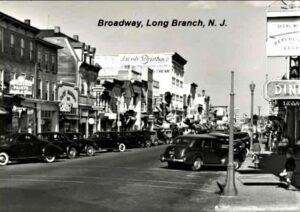
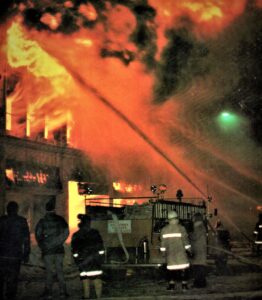
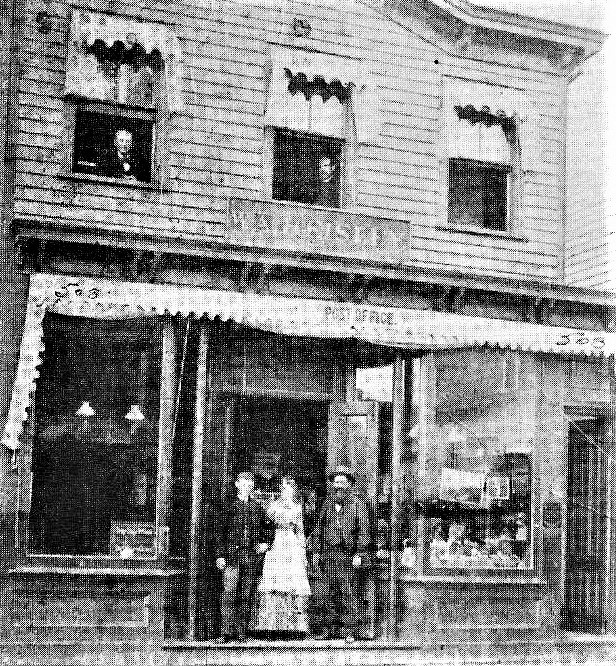
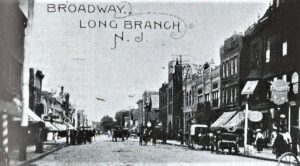
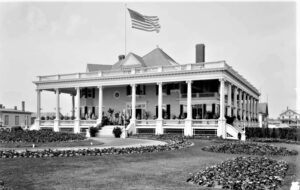
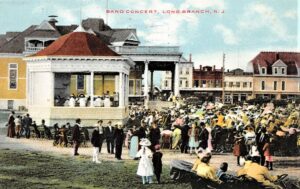
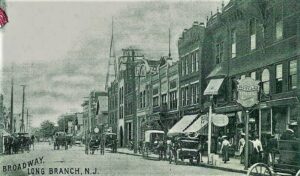
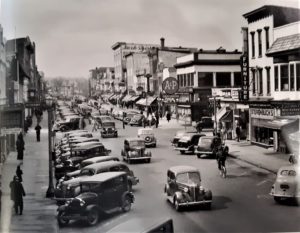
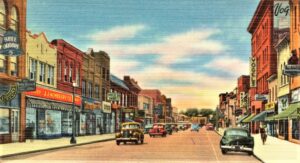
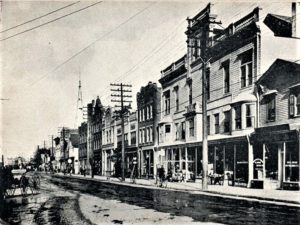
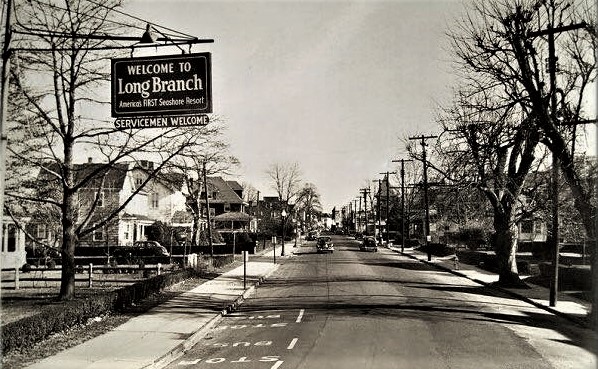
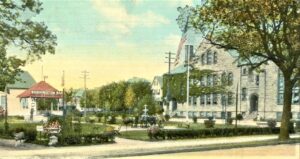
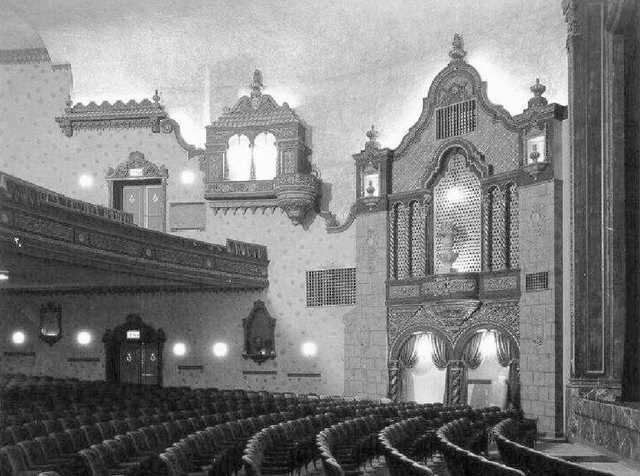
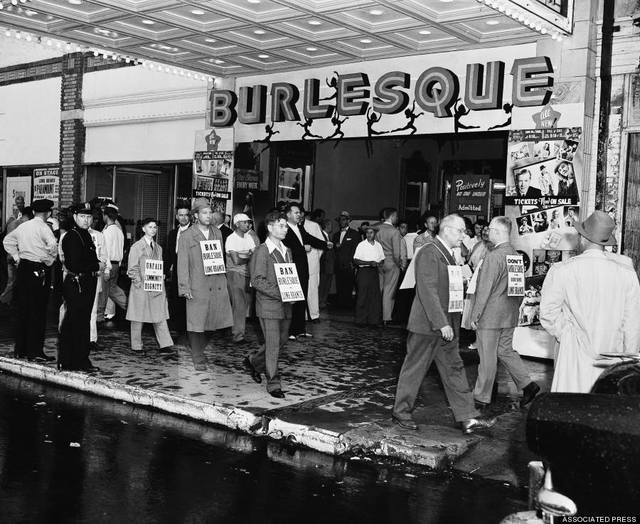
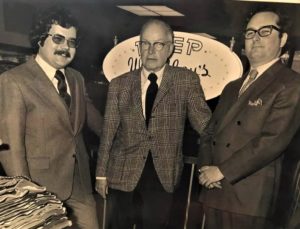
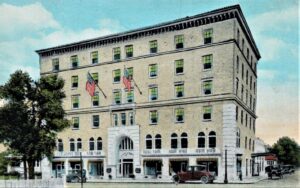
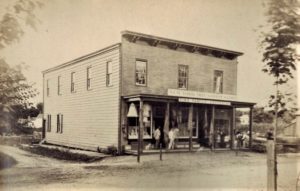
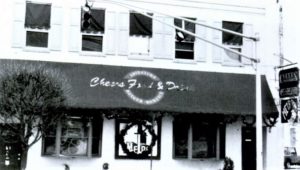

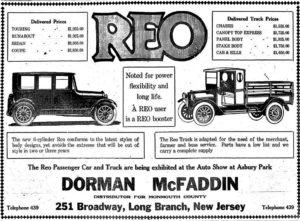
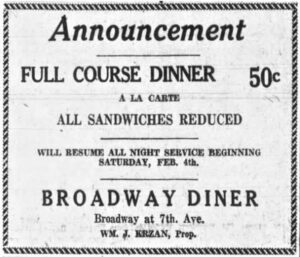
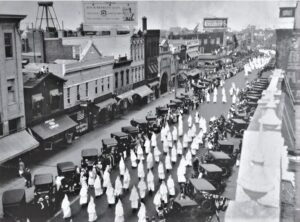
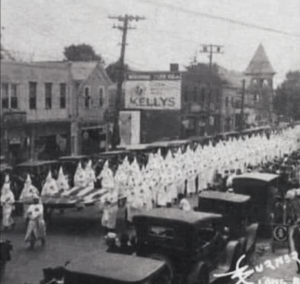
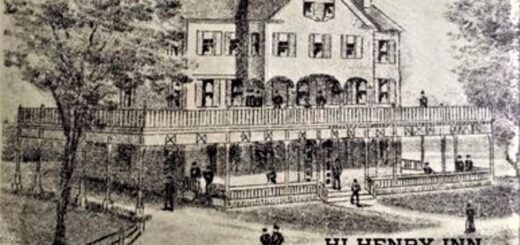
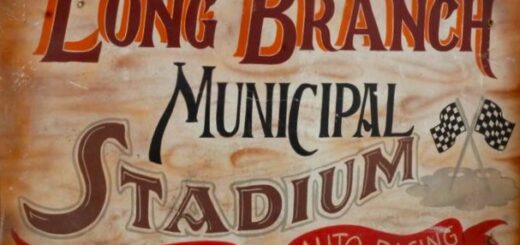
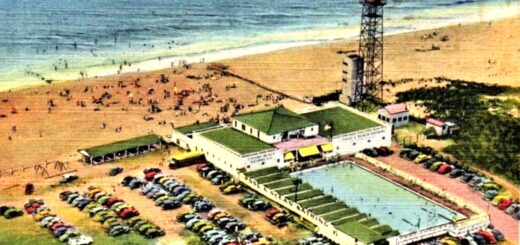

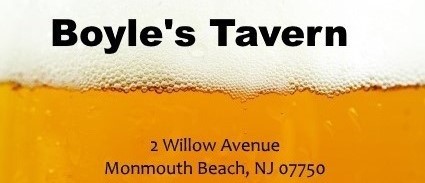
Such a great compilation of Long Branch history and downtown Broadway. I especially enjoyed pictures of my dad’s longtime store Daniels, which was originally next to Newberry’s at 198 Broadway and then moved to 186. Lots of sweet memories! Thank you!